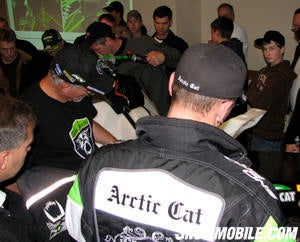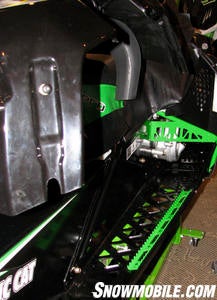At the Arctic Cat 600 SnoPro intro

Not quite an 09 preview, this racing sled may inspire innovations down the line
To drive from St. Paul to Thief River Falls, Minn. requires a seven-hour commitment. That’s almost a normal workday. It’s certainly enough time to build up a little anticipation. Snowmobile.Com’s reason for heading north was simple: Arctic Cat is based in Thief River Falls and we were invited to the unveiling of the company’s latest racing sled—the 2008 600 Sno Pro.
Ordinarily, racing sleds don’t fire us up like they used to. We had been at the introduction of the ‘real’ Sno Pro sleds in the early 1970s when teams such as Arctic were joined at unveilings by teams with names like Kalamazoo Racing and Chaparral. Those sleds were designed for one thing only, racing as fast and hard they could around iced ovals.
 Racers and crew crowd around the just unveiled 600 Sno Pro in Thief River Falls.
Racers and crew crowd around the just unveiled 600 Sno Pro in Thief River Falls.
Skime is a fixture at Arctic Cat, having been signed on by Cat’s founder Edgar Hetteen back in the 1960s. Granted, he was a lad back then, but Skime has never lost his edge for competition. It has made him a legend at Arctic Cat. His passion for snowmobiling, his hands-on approach, his competitive edge. Skime epitomizes Arctic Cat and he takes losing a bit personally for someone who could easily be living a life of luxury. But, then, if you believe Roger, he is living the good life—every day he comes to Arctic and gets to think up something new for snowmobiling.
At the intro
Once we got to Thief River Falls and joined Arctic Cat staff and the assorted racers, mechanics and their team members eagerly awaiting the 6 PM unveiling of the latest racing sled from Arctic Cat, we got a chance to see Skime and his latest go-fast project. For an hour or so we listened and looked at what was new. Then we made our way forward to the front of the hall to see the two 600 Sno Pro sleds brought for the event. Racers crowded around the sleds. We waited for a turn to get closer. Then we spotted Skime and made our way over for a chat.
If you didn’t know him by sight, you’d just think Skime was just another Cat fan. He stands straight at just less than 6 feet tall, his hair is gray. His eyes miss nothing. He watches the crowd looking at the new sled. He chats amiably with racers, team members and Arctic staff, who are not so much intimidated by his being a corporate VP and their boss, but seem more in awe of Roger Skime, the legend.
Skime explains about the new sled and how it will be suited to snocross. He seems more interested in how it will do in cross-country as he explains the subtle differences in the machine. He chats for a while, then someone asks him if he ever plans to retire. Skime looks the person in the eye and answers quickly. “Twenty years. I’ll retire in 20 years.” Then he moves away to talk with other race crews.
Roger Skime is retired in the only way that Roger Skime would ever retire. He’s doing exactly what he likes best—and it’s best for Arctic Cat that he is retired this way.
No 2009 version
The Sno Pro sled is not a precursor to a 2009 model. It borrows from existing Cats, snowmobile and ATVs. Its headlights are off a Cat ATV model. The engine is based on an F6 twin. Yet, there are innovative features that could be seen in future Cats.
The rear suspension is new, but it borrows on last year’s design. The rail extrusion height between the ribs is new. There’s a new rail cap and the rail profile is new. Much of that was predicated on larger wheel diameters at the rear axle. The suspension’s basic function remains the same as last year. The coupling block has seven positions to provide racers with setup choices. The rear suspension’s front arm can give more travel options and action between the front and rear arms can be controlled more so than in the past. The limiter strap has additional slots for more ‘tune-ability.’ Much of the change affects cross-country needs and less snocross. Cross-country riders may want to control travel, limiting the weight transfer for ice surfaces and increasing it for deeper snow in the ditches. Snocrossers will want all the travel they can get.
The track is 128-inches in overall length. This is for snocross. Riders can get better grip from the deeper lug pattern track. An available shallow lug design may work better for cross-country.
The sled has a shorter wheelbase. It should turn better and quicker in snocross. But the wheelbase with the 128-inch track will be stable at cross-country speeds and controllable in the hardpacked ditches.
 Based on the F6 twin cylinder motor, the stock 600 Sno Pro engine will make upwards of 135 horsepower on high-octane fuel.
Based on the F6 twin cylinder motor, the stock 600 Sno Pro engine will make upwards of 135 horsepower on high-octane fuel.
 This specially shaped fuel tank comes in a version that will hold either 12 or 6 gallons.
This specially shaped fuel tank comes in a version that will hold either 12 or 6 gallons.
Compression rule engine
The Sno Pro engine measures 600cc, the maximum in the new snocross rules. It is a heavily updated version of the standard twin used in the consumer available F6 series. The cylinders are new. The racing engine’s crankshaft is five pounds lighter. Twin 40mm TM flat slide carburetors replace the F6 fuel injection. There is no oil injection as racers use premixed fuel, but the engine is designed to run on pump gas. Tuned for pump gas, the stock 600cc racer will deliver about 130 horsepower. Drop in 110 high-octane fuel, readjust the timing and carburetion should get you another 4-5 horsepower.
As Steve Houle notes in the Saturday technical session, the 6.8 compression ratio satisfies a requirement of using pump gas on these racers. “It is a compression rule,” Houle says, “not a fuel rule.” Which means simply, higher octane can be used. As Cat’s engine and racing consultant, Houle provides solid hands on experience and common sense. The force behind the Speedwerx performance shop, Houle knows the racing business. He gained experience with virtually all snowmobile brands. He successfully raced telescopic strut Yamahas in an early version of snocross. He was successful with Polaris oval racers. Now he is an adviser to Cat and a presenter at the technical seminars.
Suspension updates
Also presenting to Cat’s assembled racers was Kirk Hibbert, a legendary cross-country, hill climb and snocross ace in his own right. Kirk and his test team had just gotten back to Thief River Falls the previous night, and was able to provide fresh data and input on the sled’s performance after testing in a few feet of British Columbia snow.
He told racers that although Cat had used springless Float shocks in the past, the new coil-over-spring gas shocks on the 600 Sno Pro would be just fine. He would tell the assemblage that, “We have good value in our spring shock. They are a better value for the dollar and in some cases better cornering.”
He noted that Fox is working with Cat on a piggyback reservoir shock for the immediate future. His input concerned the suspensions and he offered some thoughts based on his test driver’s inputs. He liked the new steering setup and the quicker turning ratio it had.
 The 600 Sno Pro running boards feature foot grippers.
The 600 Sno Pro running boards feature foot grippers.
Brian Dick, project engineer on the ’08 race sled, told the crews about the new, stiffer chassis. Cat’s use of self-piercing rivet technology results in a more durable race chassis. With the cowling pieces removed, you could see the pyramidal design structure that stiffens the front end. With intake and exhaust on the same side, the engine gets placed tighter up against the bulkhead to center weight for an improved center of gravity.
The chassis features wide running boards with gripper lugs to keep a riders feet secure. Hibbert noted that foot placement up in the footwells was a bit slippery but needed to be that way to allow riders to get their feet out of harm’s way in case of a crash.
Crashing seemed to be a concern for some racers as they checked out the front air intake. The nose cone features a crunch zone and ample screening to keep snow and ice from getting lodged into the carburetor air intakes. Cat engineers feel comfortable that the nose cone allows ample access to the carbs for tuning the jets and ample clearance for crash-prone racers who might rear end a competitor.
Roger’s mandate
Things that we found interesting on this latest sled were its overall look. It fulfills a mandate set down by Roger Skime: “It has to be a sled that looks like a race sled that all racers will want.”
Of course, Roger wants all racers on Cats. And all racers at the end of the season want to be able to sell their race sleds. That’s part of the reason for the pump gas 600cc engine ruling, unlike the previous high-strung 440 racers, which had no market. The new Arctic Cat 600 Sno Pro is trailable and should be an in demand sled at the end of the race season. The cross-country versions with the 12-gallon fuel tanks should be most in demand. If this sled is successful, look for some version or parts of this version to appear at a later date. Just not in 2009.
At least that’s what Skime told us. Besides, he probably has something else cooked up for us next year anyway.
Related Reading:
2008 Arctic Cat F6 Sno Pro
Arctic Cat F570
2008 Arctic Cat Crossfire








 Your Privacy Choices
Your Privacy Choices